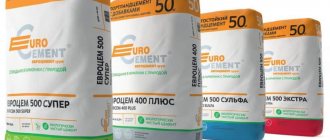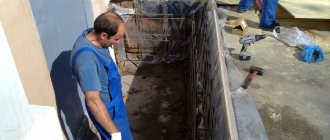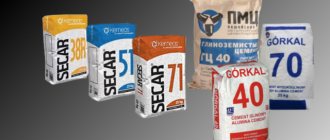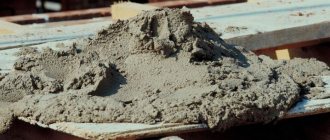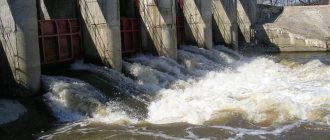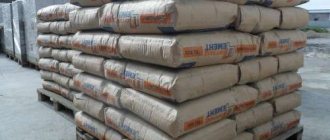Aluminous cement and its characteristics
The area of use of this material determines the property of concrete or mortar based on aluminous cement to achieve 100% of brand strength within 72 hours after mixing with water. In this case, the setting of the material proceeds in a “normal” time mode, similar to the setting period of Portland cement for general use.
The regulatory document GOST 969-91 “Aluminous and high-alumina cements” regulates the following grades and technical characteristics of a special “binder”:
| Specifications | Grade of aluminous cement GOST 969-91 | ||
| aluminous cement Hz 40 | aluminous cement GC 50 | aluminous cement GC 60 | |
| Ultimate compressive strength depending on mixing time with water, MPa | |||
| 24 hours | 22,5 | 27,5 | 32,5 |
| 72 hours | 40 | 50 | 60 |
| Setting period at a temperature of 20°C and normal air humidity | |||
| Start | 45 minutes | ||
| Ending | 10 hours | ||
| Fire resistance, °C | Not regulated | ||
In some sources you can find the designation of the binder, which does not correspond to GOST: Aluminous cement grade 400, Aluminous cement grade 500, Aluminous cement grade 600. In this case, the compressive strength of concrete or mortar is indicated in MegaPascals, and in kgf/cm2. Considering that 1 MPa = 10 kgf/cm2 this is acceptable for unofficial use.
Also, some sources report that alumina cement is a fireproof material and concrete based on it can withstand ambient temperatures from 1580 to 1750 °C. This is not entirely true.
Indeed, the heat resistance characteristics of aluminous cement are higher than those of Portland cement for general use, however, the above temperature limits of heat resistance, in accordance with the requirements of GOST 969-90, are valid for high-alumina cement grades: VGC I, VGC II and VGC III.
Application
Since every person living in a private home may be faced with the need to use the alumina option, below are instructions on how to work with it correctly.
- It is worth keeping in mind that the best way to work with this type of cement is to use a concrete mixer. It is not possible to mix the mixture so well and quickly by hand.
- Freshly purchased cement can be used immediately. If the mixture has been sitting for a while, or the shelf life is almost over, then the cement will need to be sifted first. To do this, you need to use a special vibrating sieve. The mixture is placed in it using a construction paddle auger and sieved. This is how the cement mixture is loosened and prepared for further use.
- It is necessary to take into account the higher degree of viscosity of aluminous cement compared to other types. Therefore, the cement mortar is mixed for a longer time. If in ordinary cases it takes an hour or an hour and a half, then in cases with aluminous varieties it takes 2-3 hours. It is not recommended to stir the solution longer, as it will begin to set and difficulties may arise with its application.
- Keep in mind that the concrete mixer must be cleaned immediately, since in the future, when this heavy-duty cement hardens, the washing procedure will require a lot of effort and time, not to mention the fact that sometimes it is not possible to wash the concrete mixer at all.
- If you plan to work with aluminous options in the winter, then it is worth keeping in mind a number of nuances. Since the material actively releases heat during the hardening process, all measures for diluting and applying the mixture will differ from those when working with ordinary cement mortars. Depending on the percentage of water in the mixture, its temperature can reach 100 degrees, so you need to work with extreme caution, not forgetting about safety precautions.
- If you are working with concrete that contains aluminous cement in its composition, then you need to ensure that its temperature remains at the level of 10-15 degrees and in no case rises higher, otherwise the concrete will begin to harden even before you have time to apply.
Features of alumina cement
- The setting and strength gain of concrete structures based on this type of binder should occur at a temperature of 20-0°C and high air humidity. This requirement is explained by the high exothermic reaction of the material (when hydrated, aluminous cement releases 2 times more heat than conventional cement). At an ambient temperature of 25 °C and above, a decrease in the increase in strength is observed, and with a further increase in temperature, a significant drop in strength and even destruction of the structure is possible.
- The large amount of heat generated by the material during setting and strength gain makes it possible to carry out concrete work at air temperatures down to minus 10°C without additional heating.
- Increased density of cement stone compared to cement stone based on Portland cement.
- High price, 3-4 orders of magnitude higher than the price of ordinary Portland cement.
Characteristics
Aluminous cement has a low ability to deform, since the forming stone has a coarse-crystalline structure. In addition, the presence of hydrated cubic monoaluminate results in mass loss during formation.
This material is characterized by the release of a large amount of heat, which occurs in the first few hours of hardening. This property is useful when carrying out concrete work in winter, but it reduces the range of applications for massive structures.
Expanding cement, made from alumina, is a fire-resistant material. It is used to form refractory hydraulically solidifying solutions in combination with such refractory components as fireclay, ore, magnesite.
In addition, a distinctive feature is a high-strength cement stone, which determines significant resistance to vegetable oils, acids, and sea water.
This material is capable of producing mortar and concrete with moisture resistance and significant density. But it is subject to rapid destruction under the influence of alkalis and ammonium salts.
View gallery
Scope of application
- Construction of structures that are subject to strict requirements for a minimum period of strength building.
- Construction of hydraulic and underground facilities operating in conditions of increased “sulfate” activity of the environment.
- Plugging of oil and gas wells. Tamponing cracks in rocks.
- Repairing holes in civilian ships.
- Prompt arrangement of foundations for the installation of production equipment: presses, machine tools, overhead cranes, etc.
- Repair of buildings and bridge crossings.
- Production of prefabricated concrete products as an accelerator of concrete strength gain.
- Construction of containers operating in contact with organic acids, sulfur, salt solutions and starch.
- Urgent repair work: dams, roads, foundations and other concrete structures.
The high price of alumina cement significantly limits the use of this material in private construction. The use of this material for the construction of a private building is justified if the construction of the house is carried out on a plot of land with unfavorable geodetic conditions (high groundwater levels).
Production of aluminous cement
The special properties that this type of building material has are due to its special composition and special manufacturing technology. The composition of clinker for the production of aluminous cement includes: monocalcium aluminate CaO-Al2O3, dicalcium silicate C2S, helenite - 2CaO, and other components.
To change the setting time, the following is added to aluminous cement clinker: boric acid, borax, calcium chloride to slow down the setting time, or lime, Portland cement and gypsum to accelerate the setting time.
The cement industry uses two methods for producing this type of binder: charge management technology and firing of aluminous cement components before sintering into granules.
- The melting technology consists of the main stages: preparing the charge, melting the charge in special furnaces, cooling the resulting substance, coarse crushing and fine grinding in screens to the GOST standard - the cement residue on a sieve with mesh No. 008 is no more than 10%.
- The sintering technology is characterized by the following stages: drying of the charge components, fine grinding in screens, homogenization into granules, firing in special furnaces, cooling and grinding in cement mills. There is also a requirement - “the cement residue on a sieve with mesh No. 008 is no more than 10%.”
In the Russian Federation, aluminous cement plants, as a rule, operate using the technology of melting components. The technology of sintering components is used to a limited extent.
Features of the composition
Pure limestone and bauxite are used as raw materials. The latter are rocks that consist of impurities and hydrates. Bauxite has become widespread in the industrial sector for the extraction of adsorbents, refractories, aluminum and other things.
Aluminous cement is characterized by the predominance of monocalcium aluminate in the clinker composition, which determines the main characteristics of the binder. It also contains helenite as a ballast impurity and dicalcium silicate, the characteristic feature of which is slow hardening.
When mixed with water, monocalcium aluminate begins to hydrate. The substances formed in this case act as an integral part of the frozen material. Expanding cement begins to set after 45-60 minutes, complete hardening occurs after 10 hours. It is possible to change the setting period by adding accelerators (gypsum, lime) or retarders (calcium chloride, boric acid).
View gallery
Alumina Cement Manufacturers
The high cost and specialty use of aluminous cement determines the limitation of its production. In particular, the following enterprises of the Russian Federation and companies around the world specialize in the production of this type of binder:
- OJSC Pashiysky Metallurgical Cement Plant. It produces all grades of alumina cement: GC 400, GC500 and GC600.
- (Holland).
- LLC "EMA-cement"
- (France).
- (France).
Considering that the cost of domestically produced alumina cement or imported cement ranges from 39,000 to 39,875 rubles per ton, you should carefully calculate the need for its use for the construction of the foundation and structures of a private house.
